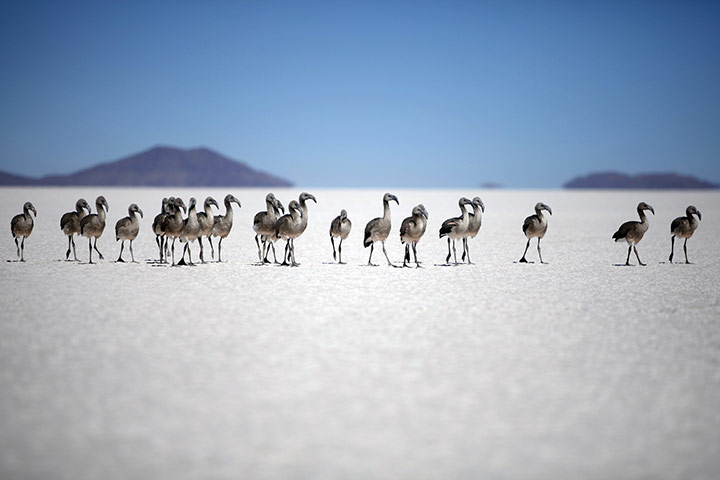TOP STORIES  Fungus Likely to Wipe Out Common Bat in Northeast United States
Fungus Likely to Wipe Out Common Bat in Northeast United States
In 2006, wildlife biologists in New York state noticed that bats were mysteriously dying in large numbers.
Covered with a white fungus, the animals woke from hibernation in midwinter and starved to death. "It's like a science-fiction scenario that came out of nowhere," says bat biologist Paul Cryan of the U.S. Geological Survey (USGS) in Fort Collins, Colorado.
Now, researchers report in the 6 August issue of Science that the rate of decline is so severe it could cause one bat species to vanish from the northeastern United States within 16 years, potentially hurting agriculture and forests.
E Stokstad
05 Aug 2010
Photo credit: A Hicks
An Emerging Disease Causes Regional Population Collapse of a Common North American Bat Species. Science. 6 Aug 2010. 329(5992): 679-682.
Related News
>>> Bats at risk of extinction [includes video]
>>> Disease 'killed one million bats'
 Gulf County Fish Kill Under Investigation
Gulf County Fish Kill Under InvestigationSomething is wrong in the waters of St. Joe Bay. State biologists, wildlife officers and health officials are trying to determine just what that is.
They responded to a fish kill in Port St. Joe and reports of oil near Cape San Blas in Gulf County on Thursday.
. . . “We want to make sure what this was,” said Commissioner Bill Williams. “Was it related to the [Deepwater Horizon] incident? Was it red tide? [We] can’t answer those questions until the analytical and the scientific approach is brought to bear.”
JM Brown
05 Aug 2010
Photo courtesy of WMBB.com
Location: Port St. Joe, Florida, USA - Map It

Related News
>>> Another fish kill fuels debate over what's causing wildlife deaths [includes video; Pass Christian, Mississippi, USA - Map It
 ]
] Newsletter of the USGS National Wildlife Health Center - July 2010
Newsletter of the USGS National Wildlife Health Center - July 2010Issue 3
In this issue:
- Founder and emeritus director of NWHC receives honorary degree/ p. 1, 2, 4
- California brown pelican mortality along the Pacific Coast/ p. 1
- NWHC Biological Technician presented with the WDA Student Research Recognition award/ p. 2
- Lead toxicosis in geese in Louisiana/ p. 3
- White-nose syndrome range expansion in winter 2009/2010/ p. 3
- Pneumonia outbreaks in bighorn sheep across western states/ p. 4
- NWHC scientist to present at 9th International Mycology Congress/ p. 5
 Reported Wildlife Mortality Events to the USGS National Wildlife Health Center Updated
Reported Wildlife Mortality Events to the USGS National Wildlife Health Center UpdatedUSGS and a network of partners across the country work on documenting wildlife mortality events in order to provide timely and accurate information on locations, species and causes of death. This information was updated on August 5, 2010 on the USGS National Wildlife Health Center web page, New and Ongoing Wildlife Mortality Events Nationwide. Quarterly Mortality Reports are also available from this page. These reports go back to 1995.
06 Aug 2010
Area: United States
TOP READ LINKS FROM LAST WEEK
News
- Migrating Birds Can’t Control Themselves
- Galápagos Islands are taken off the Unesco endangered list
- Unique link found between mad cow disease and cancer
- F&G: Wolves not causing most elk losses
- Is Africa's wildlife being eaten to extinction?
- News Digest's In the Spotlight - Wild Bird Surveillance Programs for Avian Influenza
- Prairie Dogs Have Their Day: Relocation project literally breaks ground to save them
- New Chief for USGS National Climate Change and Wildlife Science Center
- National Ban on Lead-based Ammunition, Fishing Tackle Sought to End Wildlife Poisoning Lead Still a Potent Killer of Millions of Wild Birds, Health Risk for Humans
- Scripps research study shows infectious prions can arise spontaneously in normal brain tissue
- Transport of the Pathogenic Prion Protein through Soils
- Common garden experiment reveals pathogen isolate but no host genetic diversity effect on the dynamics of an emerging wildlife disease
- Sensitive detection of scrapie prion protein in soil
- Threats of environmental mercury to birds: knowledge gaps and priorities for future research
OTHER WILDLIFE RELATED HEALTH NEWS
Photo credit: D Galdieri/AP
 The week in wildlife [image gallery]
The week in wildlife [image gallery]- Anthrax outbreak could be over - GNWT [Northwest Territories, Canada - Map It
 ]
] - Anthrax, Uganda [hippopotamuses and buffaloes; Queen Elizabeth National Park, Uganda - Map It
 ]
] - Undiagnosed die-off, fish - USA (02): (MN) catfish [Lake Zumbro, Minnesota, USA - Map It
 ]
] - How Viruses Jump from Hosts: Secrets of Rabies Transmission in Bats Discovered
- BP Spill: Static Kill Working, But Oil Still Fouls Water and Wildlife [includes video]
- Much Gulf Oil Remains, Deeply Hidden and Under Beaches
- 15 brown pelicans released in La.
- 20 turtles found in oil flown to Florida, 6 arrive at Mote
- Illnesses of at least 9 people, dog deaths may be linked to toxic algae in Ohio lake [Grand Lake St. Marys, Ohio, USA - Map It
 ]
] - State Health Department Issues Blue-Green Algae Bloom Advisory [North Dakota, USA]
- Toxic Algae Destroys Shark Brains




